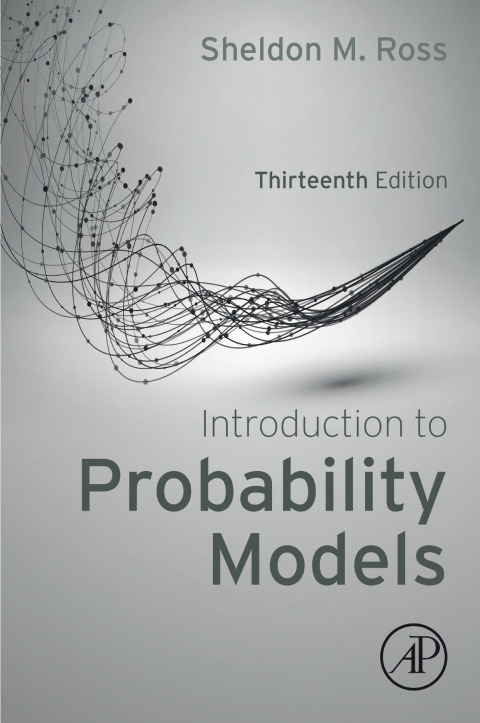Description
Efnisyfirlit
- Cover image
- Title page
- Table of Contents
- Copyright
- Preface
- New to This Edition
- Course
- Examples and Exercises
- Organization
- Acknowledgments
- 1: Introduction to Probability Theory
- 1.1. Introduction
- 1.2. Sample Space and Events
- 1.3. Probabilities Defined on Events
- 1.4. Conditional Probabilities
- 1.5. Independent Events
- 1.6. Bayes’ Formula
- 1.7. Probability Is a Continuous Event Function
- Exercises
- References
- 2: Random Variables
- 2.1. Random Variables
- 2.2. Discrete Random Variables
- 2.3. Continuous Random Variables
- 2.4. Expectation of a Random Variable
- 2.5. Jointly Distributed Random Variables
- 2.6. Moment Generating Functions
- 2.7. Limit Theorems
- 2.8. Proof of the Strong Law of Large Numbers
- 2.9. Stochastic Processes
- Exercises
- References
- 3: Conditional Probability and Conditional Expectation
- 3.1. Introduction
- 3.2. The Discrete Case
- 3.3. The Continuous Case
- 3.4. Computing Expectations by Conditioning
- 3.5. Computing Probabilities by Conditioning
- 3.6. Some Applications
- 3.7. An Identity for Compound Random Variables
- Exercises
- 4: Markov Chains
- 4.1. Introduction
- 4.2. Chapman–Kolmogorov Equations
- 4.3. Classification of States
- 4.4. Long-Run Proportions and Limiting Probabilities
- 4.5. Some Applications
- 4.6. Mean Time Spent in Transient States
- 4.7. Branching Processes
- 4.8. Time Reversible Markov Chains
- 4.9. Markov Chain Monte Carlo Methods
- 4.10. Markov Decision Processes
- 4.11. Hidden Markov Chains
- Exercises
- References
- 5: The Exponential Distribution and the Poisson Process
- 5.1. Introduction
- 5.2. The Exponential Distribution
- 5.3. The Poisson Process
- 5.4. Generalizations of the Poisson Process
- 5.5. Random Intensity Functions and Hawkes Processes
- Exercises
- References
- 6: Continuous-Time Markov Chains
- 6.1. Introduction
- 6.2. Continuous-Time Markov Chains
- 6.3. Birth and Death Processes
- 6.4. The Transition Probability Function Pij(t)
- 6.5. Limiting Probabilities
- 6.6. Time Reversibility
- 6.7. The Reversed Chain
- 6.8. Uniformization
- 6.9. Computing the Transition Probabilities
- Exercises
- References
- 7: Renewal Theory and Its Applications
- 7.1. Introduction
- 7.2. Distribution of N(t)
- 7.3. Limit Theorems and Their Applications
- 7.4. Renewal Reward Processes
- 7.5. Regenerative Processes
- 7.6. Semi-Markov Processes
- 7.7. The Inspection Paradox
- 7.8. Computing the Renewal Function
- 7.9. Applications to Patterns
- 7.10. The Insurance Ruin Problem
- Exercises
- References
- 8: Queueing Theory
- 8.1. Introduction
- 8.2. Preliminaries
- 8.3. Exponential Models
- 8.4. Network of Queues
- 8.5. The System M/G/1
- 8.6. Variations on the M/G/1
- 8.7. The Model G/M/1
- 8.8. A Finite Source Model
- 8.9. Multiserver Queues
- Exercises
- 9: Reliability Theory
- 9.1. Introduction
- 9.2. Structure Functions
- 9.3. Reliability of Systems of Independent Components
- 9.4. Bounds on the Reliability Function
- 9.5. System Life as a Function of Component Lives
- 9.6. Expected System Lifetime
- 9.7. Systems with Repair
- Exercises
- References
- 10: Brownian Motion and Stationary Processes
- 10.1. Brownian Motion
- 10.2. Hitting Times, Maximum Variable, and the Gambler’s Ruin Problem
- 10.3. Variations on Brownian Motion
- 10.4. Pricing Stock Options
- 10.5. The Maximum of Brownian Motion with Drift
- 10.6. White Noise
- 10.7. Gaussian Processes
- 10.8. Stationary and Weakly Stationary Processes
- 10.9. Harmonic Analysis of Weakly Stationary Processes
- Exercises
- References
- 11: Simulation
- 11.1. Introduction
- 11.2. General Techniques for Simulating Continuous Random Variables
- 11.3. Special Techniques for Simulating Continuous Random Variables
- 11.4. Simulating from Discrete Distributions
- 11.5. Stochastic Processes
- 11.6. Variance Reduction Techniques
- 11.7. Determining the Number of Runs
- 11.8. Generating from the Stationary Distribution of a Markov Chain
- Exercises
- References
- 12: Coupling
- 12.1. A Brief Introduction
- 12.2. Coupling and Stochastic Order Relations
- 12.3. Stochastic Ordering of Stochastic Processes
- 12.4. Maximum Couplings, Total Variation Distance, and the Coupling Identity
- 12.5. Applications of the Coupling Identity
- 12.6. Coupling and Stochastic Optimization
- 12.7. Chen–Stein Poisson Approximation Bounds
- Exercises
- 13: Martingales
- 13.1. Introduction
- 13.2. The Martingale Stopping Theorem
- 13.3. Applications of the Martingale Stopping Theorem
- 13.4. Submartingales
- Exercises
- Solutions to Starred Exercises
- Chapter 1
- Chapter 2
- Chapter 3
- Chapter 4
- Chapter 5
- Chapter 6
- Chapter 7
- Chapter 8
- Chapter 9
- Chapter 10
- Chapter 11
- Index





